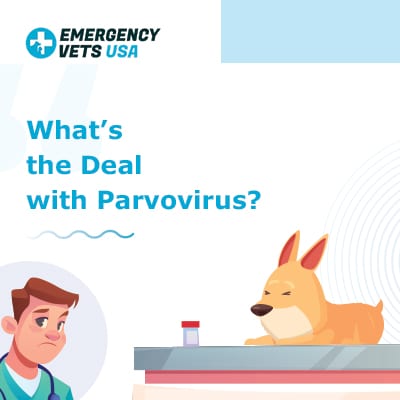What Is Parvovirus And What Causes It In Dogs?
If you recently got a new puppy you may have been warned about parvovirus (parvo, for short).
Or you may have heard the word parvo in passing when the people you got your puppy from mentioned what the puppy has been vaccinated for or what vaccines it still needs.
If you have an adult dog, you may have heard your veterinarian’s office mention it at annual visits when discussing vaccines they are due for.
Or maybe you have a puppy or dog that was recently diagnosed with parvovirus and are wondering what to expect.
In this article, we will discuss what parvo is, what it does, how to treat it.
Prevention is the end goal, due to the costs of treating parvovirus.
What Is Parvo And How Can My Dog Get It?

Parvo is a common viral disease of dogs that is extremely contagious and can be deadly if the proper protocols are not taken for treatment and prevention.
It most commonly affects puppies, but adult dogs can also become infected.
It is spread dog to dog through direct contact with infected dogs or by coming into contact with the fecal material of an infected dog.
A susceptible dog can even acquire it if they come into contact with viral particles that an infected dog left behind in an outside area or inside room that wasn’t properly disinfected.
Once a susceptible dog becomes infected, the virus attaches to the dog’s intestinal lining, causing them to become very sick.
Signs Of Parvovirus In Dogs
Once the virus attaches to a dog’s intestines, it causes severe inflammation and irritation within the gut.
This leads to the following signs:
- Severe diarrhea (usually with blood in it)
- Nausea & vomiting
- Decreased appetite or completely refusing food
- Lethargy/decreased energy
- Dehydration
- Weight loss
Sometimes these signs can almost seem to come on within a 24-hour period.
Infected dogs can become dehydrated very fast since they are not properly absorbing any nutrition or fluids and they are losing most of their fluids through vomiting and diarrhea.
How Is Parvo Diagnosed?
To diagnose parvovirus, your dog must be taken to a veterinary clinic, where a bed-side test on the dog’s stool will be performed.
The veterinary staff will collect a small sample of stool and perform the “snap” test, which comes up as either positive or negative by showing a dark blue dot.
On a rare occasion, the test may be a “false negative” if the infected dog is not yet shedding the virus in their stool.
If bloodwork is performed, the bloodwork may show anemia (low red blood cell count) and/or a low white blood cell count (this is because parvovirus can also affect the bone marrow and cause the white blood cell count to be low).
Some dogs may have a fever, while others will actually have a decreased body temperature due to the dehydration.
How Is Parvo Treated?

We do not have a specific antidote or medication to kill the virus.
Treatment is focused on providing hydration and preventing or treating secondary bacterial infections that have developed so your dog’s immune system can focus on fighting off the virus itself.
Treatment for parvo includes:
- Well-balanced fluid therapy (either intravenous/IV or subcutaneous/under the skin)
- Anti-nausea medications (usually by injection)
- Antibiotics
- Anti-diarrheal medications
- Probiotics
Once your dog’s nausea is well controlled, it is very important to offer them high-quality, easily digestible food to restore their nourishment.
This is typically offered in small portions multiple times a day to not overwhelm their recovering intestines.
Parvo is treatable and many dogs survive.
Once your dog has survived, it is very unlikely that they can get parvo twice.
However, some dogs and young puppies who are very sick may not survive treatment.
If the lining of their intestines is already too far damaged, they can become septic from the normal gut bacteria translocating over into the blood stream.
If this has already happened, the chance of them surviving is very low.
After your dog is successfully treated and is able to go home, it is very important that it is given a thorough bath.
This is so that any remaining viral particles on their fur is washed away.
The area the dog was in needs to be thoroughly cleaned with a diluted bleach solution.
Can I Prevent My Dog from Getting Parvo?
The good news is that parvo is preventable!
The best way to prevent your dog or puppy from getting parvo is to make sure they receive their parvo vaccines according to the exact schedule your veterinarian recommends.
According to the American Animal Hospital Association, the parvo vaccine is considered a “core” vaccine of dogs, which means every dog should be vaccinated for it.
The vaccine guidelines recommend that puppies as young as 6 weeks of age should receive their first parvo vaccine.
They should then receive booster doses of the vaccine every 2-4 weeks until they are at least 16 weeks of age.
One year later, they will need another booster. Then, the vaccine only needs to be given every 3 years.
It is also important that young puppies are not allowed contact with other dogs or puppies who are not vaccinated, or who the vaccine status is unknown.
Try to avoid taking young puppies to pet stores and other places with many dogs until they have received at least 2 doses of the parvo vaccine.
Because parvovirus is preventable and can be very expensive to treat, make sure to take your puppy to see a veterinarian shortly after you acquire them to keep them on their proper parvo vaccination schedule.
It’s also important to maintain a relationship with a veterinary clinic throughout the years to ensure your adult dog stays up to date on their parvo vaccine as well.
Can Parvo Lead To Emergencies?
As mentioned above, this can be prevented or treated if your dog does get parvo.
An emergency can develop if your dog is bleeding too much, or has an advanced case of Parvo.
For this reason if you suspect your dog may have this disease, contact your regular veterinarian clinic as they will either have you come in or go to a nearby emergency animal hospital for treatment.

Leslie Brooks graduated from the University of Tennessee College of Veterinary Medicine in 2012. After graduation she moved to Indianapolis to do an intensive one-year internship at a specialty practice and then began working as a small animal general practitioner. She ran her own house call practice for three years, visiting pets in people’s homes. Currently, she works part time in clinical practice and volunteering her free time to serve pets of the homeless. Read more about us here.
